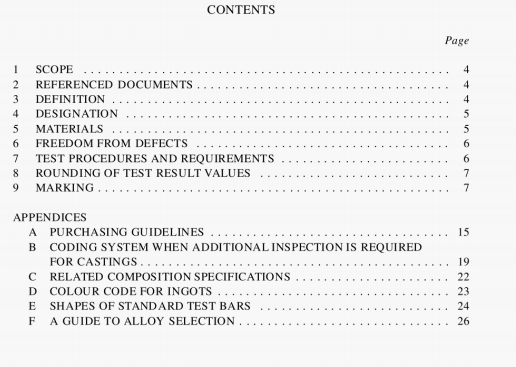AS 1565:1996 pdf – Copper and copper alloys- Ingots and castings.
7.1.2 Tensile lest The 0.2% proof stress, tensile strength and elongation shall be determined in accordance with AS 1391 on test pieces manufactured from test samples (see Clause 7.1.1).
If any test piece appears to contain casting defects. (he results of the test shall be discarded. and a further test made using a test piece taken from the same test sample. The results obtained shall be substituted for those of the defective test piece.
The elongation results shall he reported on a gauge length of L, = 5.65IS,,. where S,, is the cross-sectional area of the test piece before testing.
NOTE: The 0.1% permanent set stress may also be used as a basis for acceptance (see AS 1391). The values of this lest are approximately equivalent to the 0.2% proof stress values.
7.1.3 Hardness Brinell hardness tests shall be made in accordance with AS 1816, using. whenever possible, a 10 mm ball and a load equivalent to a mass of 10(X) kg. Where this is not suitable, an alternative is to use a F/U2 ratio of 10. where F is the test force, in newtons, and D is the diameter of the ball, in millimetres.
The test shall consist of three determinations, the average being regarded as the BnneIl hardness of the material.
7.2 Electrical tests
7.2.1 Resistit’irv lest The resistivity test shall be carried out in accordance with BS 5714 on a suitably cast test piece of sufficient length to give the accuracy required.
For calibration and in cases of dispute, the accuracy of the measurement shall be ±1% and the resistivity corrected to a temperature of 20°C.
7.2.2 Conductivity When required. conductivity may be determined as an alternative to resistivity.
Conductivity testing shall be carried out using an eddy current testing instrument which is calibrated and operated under the conditions recommended by the manufacturer. The test sample surface shall be suitably prepared.
8 ROUNDING OF TEST RESULT VALUES
8.1 General With the exception of tensile test results, the observed or calculated values
shall be rounded to the same number of figures as in the specified values and then compared
with the specified values. For example. for specified maximum or minimum values of 2.5,
2.50 and 2.500, the observed or calculated value would be rounded to the nearest 0.1. 0.01
and 0.001 respectively (see also AS 2706).
8.2 Tensile test results The determined value of tensile strength shall be rounded to the nearest 10 MPa and the determined value of the 0.2% proof stress shall be rounded to the nearest 5 MPa.
AS 1565:1996 pdf – Copper and copper alloys- Ingots and castings
